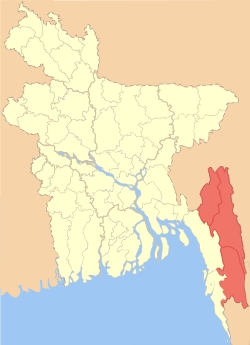Operation Golden Bird
| Operation Golden Bird | |||||||
|---|---|---|---|---|---|---|---|
| |||||||
Operation Golden Bird was an Indian-Myanmar military operation which occurred in April–May 1995.[1][2][3][4][5] The operation was initiated by the 57th Mountain Division of the Indian Army , which tracked down and decapitated a rebel column that had picked up a huge consignment of weapons at the Wyakaung beach (on the Myanmar-Bangladesh coast south of Chittagong and Cox's Bazar, Bangladesh),[6] and was moving that through the jungles of Mizoram, Northeast India.[7] The consignment was to be delivered in Manipur, India.[8] The operation was named after a Grimm Brothers fairytale.[9] Operation Golden Bird was a joint India-Myanmar military operation carried out along the Mizoram border that led to the elimination of dozens of terrorists.[10] It was one of the successful counter-insurgency operations of Indian Army.[11] The counterpoint to Golden Bird was Purulia arms drop case.
Background
The weapons were purchased in Thailand and were brought by sea to Bangladesh. Then these weapons were smuggled back to Northeast India by groups of rebel guerrillas marching back. Wyakaung beach located south of Bangladesh’s coastal town of Cox’s Bazaar was the favourite landing spot for these weapons, but at least six other points in the Cox’s Bazaar district were used. The guerrillas of the NSCN, the Manipuri groups, the ULFA and the NDFB would then pick these and carry them back through one of three routes: (a) the Chittagong Hill Tracts-south Mizoram-east Manipur route, skirting the border with Burma; (b) the Chittagong Hill Tracts-tripura-west Mizoram-west Manipur route and (c) the Chittagong-Sylhet-Meghalaya-Assam route. In the last several years, Sylhet-Meghalaya has been used more frequently by the rebels. The Directorate General of Forces Intelligence (DGFI) has helped the Northeast Indian rebel groups to safely land these weapons and only on a few occasions have weapons meant for these rebel groups been intercepted by the Bangladesh police, who were misled into believing that the weapons were intended for criminals in that country. With Bangladesh emerging as the gateway to Northeast India for weapons brought in from Thailand, the rebels in Tripura were best located to carry them back. Both the National Liberation Front of Tripura(NLFT) and the All-Tripura Tiger Force(ATTF) have secured weapons from NSCN. The NDFB and ULFA helped them cache the weapons at their bases in the Chittagong Hill tracts before they were carried to their respective base areas in Northeast India.
The operation

Operation Golden Bird was initiated to intercept a column of north-eastern rebels —Naga, Manipuri and Assamese — making its way through the jungles of southern Mizoram after picking up a consignment of weapons that had landed at Wyakaung beach, on the Myanmar-Bangladesh coast.[12] The operation was aimed at flushing out ULFA, NSCN and Manipuri fighters in camps along the border. Bangladesh military intelligence service Directorate General of Forces Intelligence(DGFI) had helped carry the consignment in trucks to a hill base in the Chittagong Hill Tracts, from where the rebels had picked them up. National Unity Party of Arakan(NUPA) guerrillas followed the whole operation, providing details to Indian military intelligence, on the basis of which India’s eastern army command initiated Operation Golden Bird. The rebel column was twice intercepted by Indian troops.It was a 45-day operation, but the operation ended abruptly as Rangoon ordered its army to pull out of the operation in the middle of operation.[13][14] The Myanmar army played its part by sealing its side of the border until the awarding of the Jawaharlal Nehru Award to Aung San Suu Kyi upset them and the survivors of the trapped rebel column managed to escape into the wilds of Myanmar’s Chin Hills through gaps in the dragnet caused by the Myanmar Armed Forces’s (Tatmadaw) withdrawal.[15]
Casualties
38 rebels were killed, and 118 captured and more than 100 weapons were seized with large quantities of ammunition.[16][17][18] The captured rebels blew the lid on the weapons trail and India pressured Bangladesh during Khaleda Zia's first government(1991-1996) to block it. The Burmese army had taken some casualties in this operation.
Aftermath
Purulia arms drop case followed after this operation on 17 December 1995.[19][20]
See also
- Chin Hills
- Indo-Burma barrier
- Purulia arms drop case
- Chittagong Hill Tracts
- Cox's Bazar
- Insurgency in Northeast India
- Arakan Mountains
References
- ↑ "ARMS AND THE MEN".
- ↑ "China has lost the 'Jade kingdom', India must not". Rediff. 27 May 2012.
- ↑ "Before Myanmar, There Were These Five Great Indian Military Ops".
- ↑ "India seeks release of Suu Kyi". The Hindu.
- ↑ "India seen arming Burma to counter Chinese". The Washingtion Times.
- ↑ "Troubled Periphery: The Crisis of India's North East By Subir Bhaumik".
- ↑ "SLIPPING THROUGH GAPS IN THE DRAGNET".
- ↑ "India and Myanmar: Choices for Military Cooperation" (PDF).
- ↑ "Cross-border Operations: How MEA helped set stage for strike".
- ↑ "The view from New Delhi-Praveen Swami".
- ↑ "Manipur ambush: Why Army saw the worst attack in 20 years".
- ↑ "2004 Chittagong arms haul case exposes many terror links".
- ↑ "'Myanmar key to curbing northeast border insurgency'".
- ↑ "4. India–Burma relations" (PDF).
- ↑ "Myanmar strike: This is not the first time India has conducted cross-border operations".
- ↑ "NSA skipped Dhaka trip to plan Myanmar Op".
- ↑ "Tehelka - India's Independent Weekly News Magazine". tehelka.com.
- ↑ "The Tribune, Chandigarh, India - Opinions". tribuneindia.com.
- ↑ "Purulia Expose: India's best kept secret".
- ↑ "Purulia arms drop case resurfaces with new set of revelations".